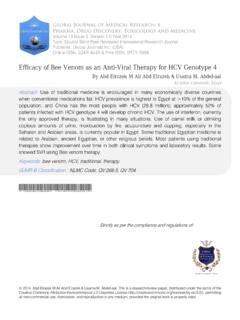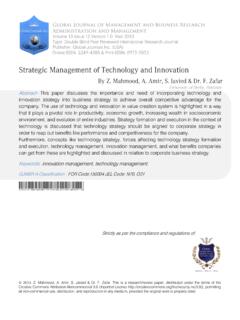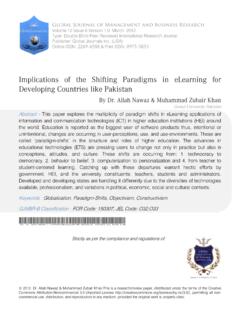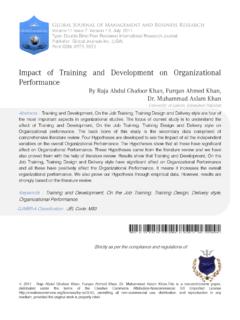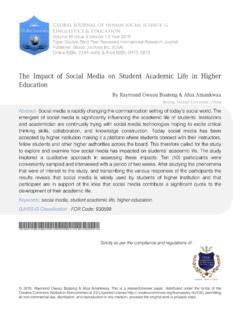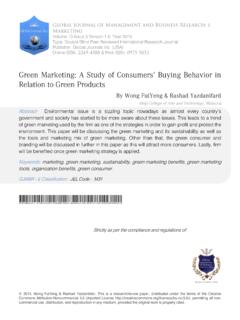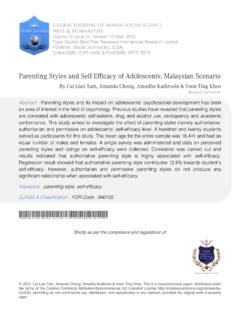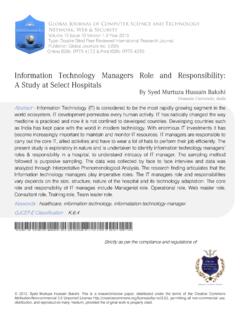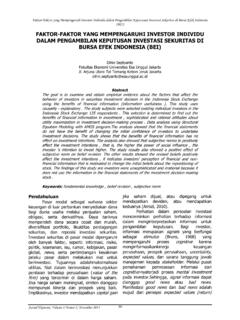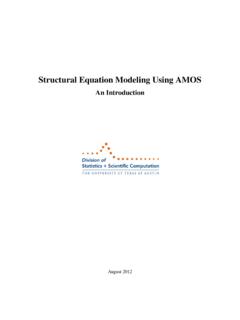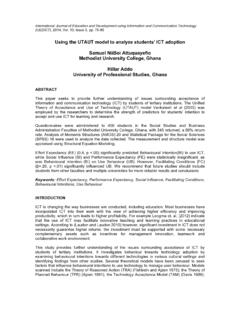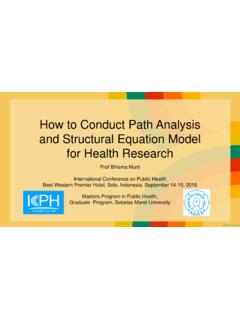Transcription of Impact of Organizational Change on Organizational …
1 Global Journal of Management and Business Research: A Administration and Management Volume 16 Issue 3 Version Year 2016 Type: Double Blind Peer Reviewed International Research Journal Publisher: Global Journals Inc. (USA) Online ISSN: 2249-4588 & Pr int ISSN: 0975-5853 Impact of Organizational Change on Organizational Performance Aligarh Muslim University, India Abstract- Purpose: The purpose of this paper is to explore the relationship between the aspects of Change and Organizational performance as well as to study the Impact of these aspects of Change on performance.
2 Methodology: This study sought to explore the influence on Organizational performances. The constructs considered in the study includes quality of Change communication, participation, attitude of top management toward Change , leadership and readiness for Change on performance in the organization. A research instrument was designed based on extensive literature review of the Change , and Organizational performance and datawere collected from organizationsthat were segregated on the basis of the public and private sector and also manufacturing and service research instrument was pilot tested, and necessarymodification was reliability and validity of the instrument weredetermined using Exploratory Factor Analysis (EFA).
3 Keywords: Organizational Change , performance, Change communication. ImpactofOrganizationalChangeonOrganizati onalPerformance Strictly as per the compliance and regulations of: By Saira khatoon& Dr. Ayesha Farooq 2016. Saira khatoon& Dr. Ayesha Farooq. This is a research/review paper, distributed under the terms of the Creative Commons Attribution-Noncommercial Unported License ), permitting all non-commercial use, distribution, and reproduction in any medium, provided the original work is properly AClassification: JELCode :D23 Impact of Organizational Change o n Organizational Performance Saira khatoon & Dr.
4 Ayesha Farooq Abstract- Purpose: The purpose of this paper is to explore the relationship between the aspects of Change and Organizational performance as well as to study the Impact of these aspects of Change on performance. Methodology: This study sought to explore the influence on Organizational performances. The constructs considered in the study includes quality of Change communication, participation, attitude of top management toward Change , leadership and readiness for Change on performance in the organization. A research instrument was designed based on extensive literature review of the Change , and Organizational performance and datawere collected from organizationsthat were segregated on the basis of the public and private sector and also manufacturing and service research instrument was pilot tested, and necessarymodification was reliability and validity of the instrument weredetermined using Exploratory Factor Analysis (EFA).
5 Data was generated and then subjected to analysis. Confirmatory Factor Analysis (CFA) was carried out where the measurement model for Organizational Change and performanceentire scale was estimated using amos The impacts of the aspects of Change on performance were determined by using structural Equation modeling where the measurement model for entirescale was estimated using amos Equation Model fit indicators for entire scale were found acceptable according to recommended values. Findings: The variables related to Change portrayed in the research instrument are the aspects of Change management in organizations; both for the individual as well as groups and the work also gains insight into the effects of the Organizational Change on Organizational performance.
6 This research instrument offers the Impact of Change aspects on performance and subsequently, improvisation of the processes in future. The results obtained indicated a positive relationship between theaspects of Change on performance, as well as they,impacted the performance of the organizations. Managerial Implications: The researchers have concluded that the adoption of the changes by companies can be a means to improve Organizational performance. The adoption will assist the business organizations to formulate practical strategies to enhance their performance.
7 Keywords: Organizational Change , performance, Change communication. I. Introduction ccording to Kotter (1995), effective Change efforts must begin with individuals and groups evaluating an organization s market position, competitive Author : Aligarh Muslim University. e-mail: A 2016 Global Journals Inc. (US)1 Global Journal of Management and Business Research Volume XVI Issue III Version IYear ( )A2016situation, technological developments and financial performance .The Organizational Change implemented by the commitment of top management and it respondto various demands from a dynamic competitive environment (Wright and Snell, 1998).
8 Increasing global competition, accelerating technological Change and expanding customer expectations are creating a turbulent environment. In order tothis rapid and uncertain Change , organizations combine different aspects of Change to improve performance and adopt flexible workplacepractices in order to be successful (Gittleman et al., 1998). Armenakis et al. (1993) cite the example of a CEO, who travels to numerouscorporate locations in order to discuss the need for researchers have shown that aspects of Change such as Change communication, participation, theattitude of top management, leadership and readiness for Change are related to increasingorganizational performance, the contribution of these aspects of Change has been studied empirically(Bhattacharya et al.)
9 , 2005).However, aspects of Change lay the foundations for the Change in the organization: Quality of Change communication is vital to the active implementation of Organizational Change (DiFonzo and Bordia, 1998; Lewis and Seibold, 1998; Schweiger and Denisi, 1991) and has made work more portable and ubiquitous which increases employee flexibility to organize work (Moen,1996).Communication meansthe exchange of information and the transmission of meaning (Gilley et al., 2009). The most important factor for failure in Change attempts is the managers inability to persuade organization members to support the Change (Fox and Amichai-Hamburger, 2001).
10 Participationof top managementand employees in an Organizational context is demarcated as the active contribution of employees and management in the decision-making process of anorganization(Chirico &Salvato, 2008).The attitude of top management, toward Organizational Change ,is defined as a top management s psychological tendency expressed by overall positive or negative evaluative judgment of Change (Lines, 2005). Attitudes toward Organizational Change could be viewed as a complementary to the acceptable (bottom line) outcomes, such as survival and profitability (Armenakis and Bedeian, 1999).


